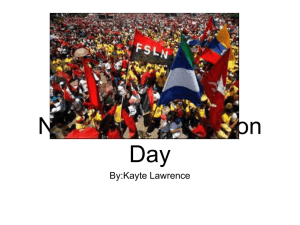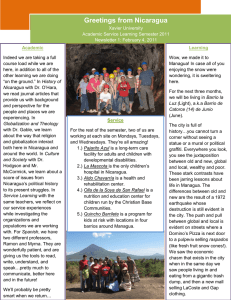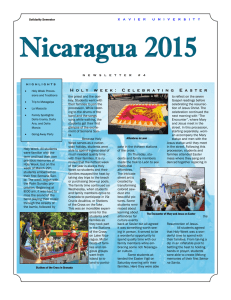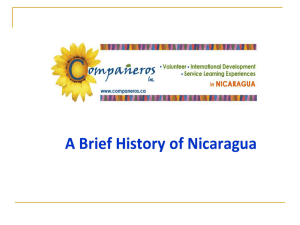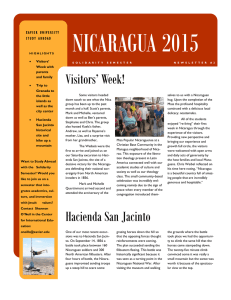El Encaminador The Atlantic Coast
advertisement
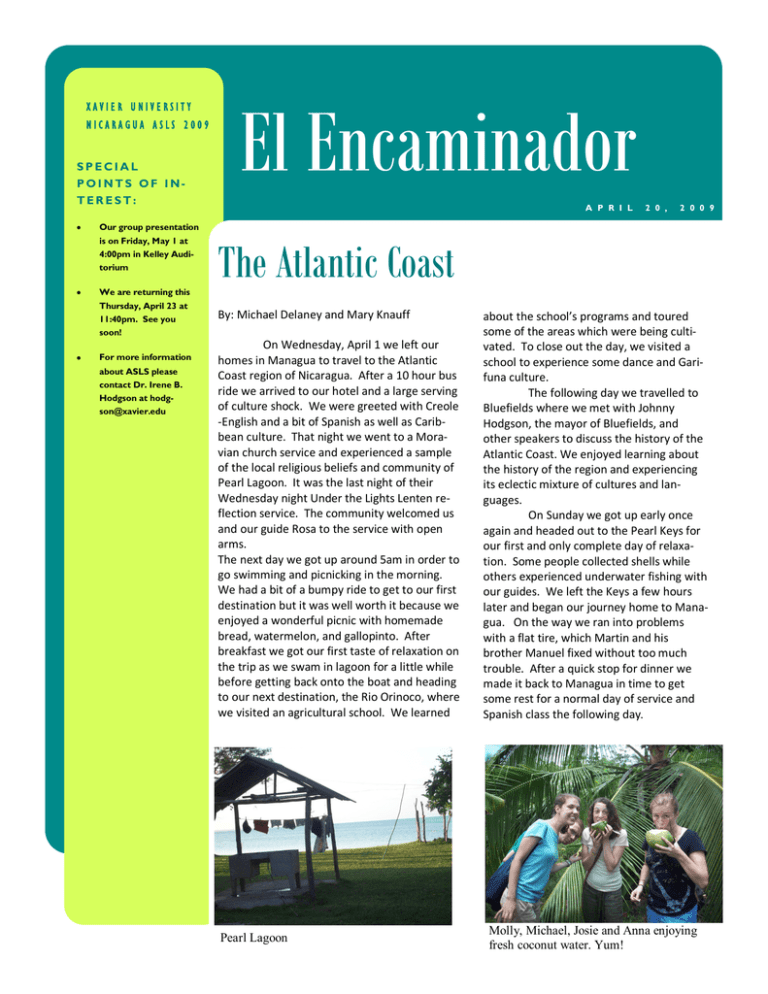
XAVIER UNIVERSITY NICARAGUA ASLS 2009 SPECIAL POINTS OF INTEREST: El Encaminador A P R I L 2 0 , 2 0 0 9 Our group presentation is on Friday, May 1 at 4:00pm in Kelley Auditorium We are returning this Thursday, April 23 at 11:40pm. See you soon! For more information about ASLS please contact Dr. Irene B. Hodgson at hodgson@xavier.edu The Atlantic Coast By: Michael Delaney and Mary Knauff On Wednesday, April 1 we left our homes in Managua to travel to the Atlantic Coast region of Nicaragua. After a 10 hour bus ride we arrived to our hotel and a large serving of culture shock. We were greeted with Creole -English and a bit of Spanish as well as Caribbean culture. That night we went to a Moravian church service and experienced a sample of the local religious beliefs and community of Pearl Lagoon. It was the last night of their Wednesday night Under the Lights Lenten reflection service. The community welcomed us and our guide Rosa to the service with open arms. The next day we got up around 5am in order to go swimming and picnicking in the morning. We had a bit of a bumpy ride to get to our first destination but it was well worth it because we enjoyed a wonderful picnic with homemade bread, watermelon, and gallopinto. After breakfast we got our first taste of relaxation on the trip as we swam in lagoon for a little while before getting back onto the boat and heading to our next destination, the Rio Orinoco, where we visited an agricultural school. We learned Pearl Lagoon about the school’s programs and toured some of the areas which were being cultivated. To close out the day, we visited a school to experience some dance and Garifuna culture. The following day we travelled to Bluefields where we met with Johnny Hodgson, the mayor of Bluefields, and other speakers to discuss the history of the Atlantic Coast. We enjoyed learning about the history of the region and experiencing its eclectic mixture of cultures and languages. On Sunday we got up early once again and headed out to the Pearl Keys for our first and only complete day of relaxation. Some people collected shells while others experienced underwater fishing with our guides. We left the Keys a few hours later and began our journey home to Managua. On the way we ran into problems with a flat tire, which Martin and his brother Manuel fixed without too much trouble. After a quick stop for dinner we made it back to Managua in time to get some rest for a normal day of service and Spanish class the following day. Molly, Michael, Josie and Anna enjoying fresh coconut water. Yum! P AGE 2 The Amadors By: Mary Renda After a long day of service and class I usually open the gate of my house, walk past the screeching parrots, and barely begin entering the house when I here “Mari ya viene. Mari, Mari vamos a jugar!” (Mary is coming. Mary, Mary let’s play!) from my five-year-old sister Daniela. She takes me by the hand, sits me down and either cooks an imaginary dish for me, tells me that we are going on an adventure through the rainforest, or plays with my hair telling me that she is preparing me for school. After sitting with Daniela for a few moments, my abuelita (grandma) walks outside and seeing Daniela on my lap, squints up her face angrily and says, “Daniela, ¡qué necia! Dejala!” (Daniela, what a bother! Leave her alone!). After explaining to my abuelita I am fine, she begins to laugh and we continue laughing together until she asks about my day. Doña Juanita, my abuelita and the head of the house, has become my teacher in Nicaragua. Not only has she taught me how to wash my clothes, cook, plant flowers, clean, and shop in a Latin American market, she has taught me how to live life with persistence and joy. Doña Juanita is the mother of three women, Mayra, Martha, and Marcia. She was a single mother raising her three girls through the Revolution and Contra-Revolution and continues to do almost all of the cooking, shopping and operating the pulperia outside of our house. My Nicaraguan mother Dona Marcia is also a single mother caring for her two children Mario, 16 years old, and Daniela, 5 years old. I am constantly inspired by the strength and love with which Doña Marcia dedicates to her family. Every morning at 5:30, Dona Marcia wakes up to wash clothes and prepare for work. After long days of work or classes, Marcia comes home to care for Daniela and talk and laugh with Mario. I have found that I cannot be around my brother Mario for five minutes without laughing. Whether we are creating balloon animals, jumping over a slinky, having a water fight, chasing Daniela, or throwing food, we are always laughing. Mario finds ways to not only tease me, but everyone in the family, including my aunt, who once chased him throughout the whole house with a stick. In addition to my aunt Mayra’s wonderful retaliation against Mario, she also has a wonderfully caring heart, always telling me that I can talk to her about anything and always asking me how I am feeling. Doña Juanita has explained to me that her house is poor and humble, but full of love and care. The Amadors of this house will always be in my heart as my family and as a wonderful inspiration of how to live with strength and joy. Mary and her sister Daniela EL ENCA MINA DOR P AG E 3 La Mascota By: Mary Knauff Anna’s and my service over the past semester was at La Mascota, a children’s hospital, where for three days a week we spent time with children in the oncology and hematology wards. La Mascota is the only children’s hospital in Nicaragua and as such it receives children from across the country for medical treatment. Although the services are mostly free, many of the families face difficulties with transportation and with leaving behind household and work responsibilities in order to stay at the hospital with their child. During our time at La Mascota, we met many children and parents who inspired us with their ability to find the strength and courage to continue fighting for life despite all of the obstacles they face. We both became close to several children and over time began to understand their lives and feel their pain and happiness. At times it was difficult to find hope as we realized the realities of the lives of these children. As our service has come to an end, we are still struggling to understand how the future will progress for our friends at La Mascota. Despite our struggles we hope that we brought some joy to the children with our funny sounding Spanish and our crazy games and coloring books. The Castro Family (pt. 1) By: Anna Russell The first few days in my Nicaraguan home of the Castros, I had absolutely no idea who actually lived there. Throughout the days, it seemed like hundreds of people passed through the front door, said “buenas dias,” grabbed some gallopinto (Nicaraguan’s delicate mixture of rice and beans) hung some clothes on the line, and chatted with Doña Coco in the kitchen, where she permanently stations herself to cook and clean. After some intense questioning, I have figured out the interrelationships between the people in my house and will try to explain them. Twelve people from four branches of the Castro family tree reside permanently in my house. On average, fourteen people sleep in the house—with the invariable addition of a myriad of cousins, nieces, nephews and boyfriends—i.e., when my niece Paulina’s boyfriend is in Managua for his band tours. And a mix of more than twenty neighbors, estranged family members, friends and residents regularly eat Doña Coco’s famous gallopinto, plátanos and queso. To make things more confusing, three of the women who tend to live in my house are currently working in Italy and several extended family members are spread between Costa Rica and Spain. One of my favorite additions is three year old Isac, the screaming wonder and pseudo-cousin who, most easily explained, is my matriarch figure’s great grandson. Nicknamed “Little Monster,” Isac roars into the house and demands that I jump outside with him, squish playdough on the floor or chase one of the five dogs that live with us. Although the relationships within the family are complicated, Castros always come before anyone else, and I am lucky to be considered a temporary Castro. Last week, Doña Coco celebrated her birthday (let’s just say she’s a gray-haired twenty-five-year-old) and all the family members came out of the woodwork to shower the woman who never sleeps with admiration, gifts and chicken cooked out on the sidewalk. When my family worried that my eardrum might explode, Carlos, a doctor and relative, escorted me to the public ER, where one of his pals took a good look at my left ear. La Olla de la Soya By: Molly Rehak and Paul Madden Our service days begin “off the ground running”— literally. The moment we step through the gate we are greeted by the energy and excitement of children, and lots of them. We each work in our respective classrooms, Paul with two and three-year olds and Molly with the next level of three almost four-year olds. The days are filled with games, learning the alphabet, numbers and colors and then eating together the snack of soy made by the loving hands of volunteer mothers from the neighborhood. All of this happens within the three hour period that we are there. The mission of the organization in general is to provide a nutritious snack to children made of soy products in an attempt to prevent malnutrition or development problems. They also place a strong emphasis on the integration of the family members of the children into the functioning of the program. They help cook and clean the classrooms and are on a rotation for these jobs. One of the best parts of our role there is to be able to get to know the children since we have pretty consistent roles in our classes. There is one pair of sisters there, Maritza (in Paul’s class) and Belking (in Molly’s class) that have certainly kept us busy. They are both so full of energy but are two with whom we have had much time to interact. Their matching energy and inability to tire make the fact that they are sisters all that much more natural. All in all, our service site has provided us with many laughs, a full belly on the days we can try the food, lots of exercise and a new appreciation for the use of soy. Our time at the Olla has been an experience we will never forget! Mi familia nicaragüense: The Castro Family (pt. 2) By: Molly Rehak Every morning my day begins with a “Buenos días Molly, ¿cómo dormiste” the moment I open my eyes. My wonderful sister Kenia and I share our room and whether we are awoken by the loud music on our street or the woman selling bread, we begin each day the same. Kenia is 18 and in her second year at the U.C.A. (The Jesuit University of Central America). She is super fun, absolutely loves the color pink, has a fantastic fashion sense (with which she tries to help me whenever she can) and is teaching me to dance-without much success due to my lack of skills. I also have a seven-year old brother named Kenneth who has tons of energy, who also loves to dance, sings at the top of his lungs to Daddy Yankee, and gives me the best/strongest hugs I have ever received. My mom here, Blanca is a great and caring mother. She has a wonderful sense of humor and I love the times when the two of us can sit and talk and/or watch our favorite novela (soap opera) together. My Nicaraguan father, Martín *son of Doña Coco/ “The Castro family (pt. 1)” + is a great caretaker not only of me, but for entire group as he is our driver. It is wonderful to always have a member of my family with me on all of our trips. Martin is also an incredibly talented microbus driver as well as taking the bus through rivers, up cliffs and through some of the rockiest roads I have ever seen! He also has the amazing ability to make us all fall over in laughter. All in all, my family life here is incredibly fun, caring and filled with so many laughs! They help me feel better through the longer days and I definitely feel as though I have new family members who just happen to reside in Nicaragua. I have been blessed to meet these four individuals and now can not imagine my life without knowing them! El Arenal By: Michael Jonagan Dust poured unremittingly into the microbus as we bumped down the rural road, each turn of the wheels leaving the light, noise, and movement of the city behind. Cicadas howled as we turned into a dusty lot fronting a clinic and a small pavilion. Gathered on the front patio were a group of young people who welcomed us with warmth and sincerity to their home. El Arenal is the name of both a village and the region that surrounds it. Roughly 6,000 souls live in the handful of villages splayed across this wild western flank of Nicaragua. As we sat down and began to introduce ourselves, we could see emerging a portrait of Nicaragua that before had been obscured by the car exhaust and reggaetón of Managua. Our hosts told us about their constant struggle with the state water company for even the most basic service, citing examples of comrades who had been without water for months at a time. An older woman named Martha explained the community’s history of struggle, saying that though much had been gained, rural Nicaragua suffers in a state of neglect and abandonment. In 2006, for the first time since the fall [electoral defeat] of the Nicaraguan revolution in 1990, some programs were implemented to assist the spurned campesinos. Unfortunately, many of the programs have been burdened with corruption and inefficiency. After concluding our initial reflection with Martha, each member of our group went with a different host to spend the night in the far-flung villages. I was placed with a young woman named Luvy in the village of Cruz de Mayo, about four kilometers from the clinic. We arrived to a simple meal of gallopinto and cheese, and talked on the porch. Around us, the night sank profoundly over every discernible shape, leaving only the sulfur glow of the porch light. I knew a darkness and a silence that would seem absurd in bustling Managua, and without the buzz of the television and the vibrations of trucks and buses, I sank into my chair, tired and at peace. After saying good night to Luvy, I spent my first night in the campo, alternatively sleeping and listening to Mother Nature’s nocturnal chorus. The rooster, markedly more ambitious and persistent than any in Managua, began to wake me around midnight, and gave reminders every hour or so until dawn. After scrubbing off my sleep with a bucket bath, and taking my bread and coffee, I set off with Luvy towards the clinic. A university student and activist, Luvy is a product of two Nicaraguas. She was born and raised surrounded by her family, their coffee crop, and the ever-present livestock. She has bridged the gap between city and campo in her studies at the Jesuit Universidad Centroamericana, where she is training to be a psychologist. Her generation, the rest of her youth group, will have to confront the challenges and shortcomings left to them by the Sandinistas and their neoliberal opponents. I felt a deep sense of hope when Luvy told me that even though she had been to Spain and seen the first world, she still preferred her Nicaragua, rural Nicaragua. This country needs defenders and strugglers such as Luvy, and has them abundantly in the small, pugnacious community of El Arenal.
